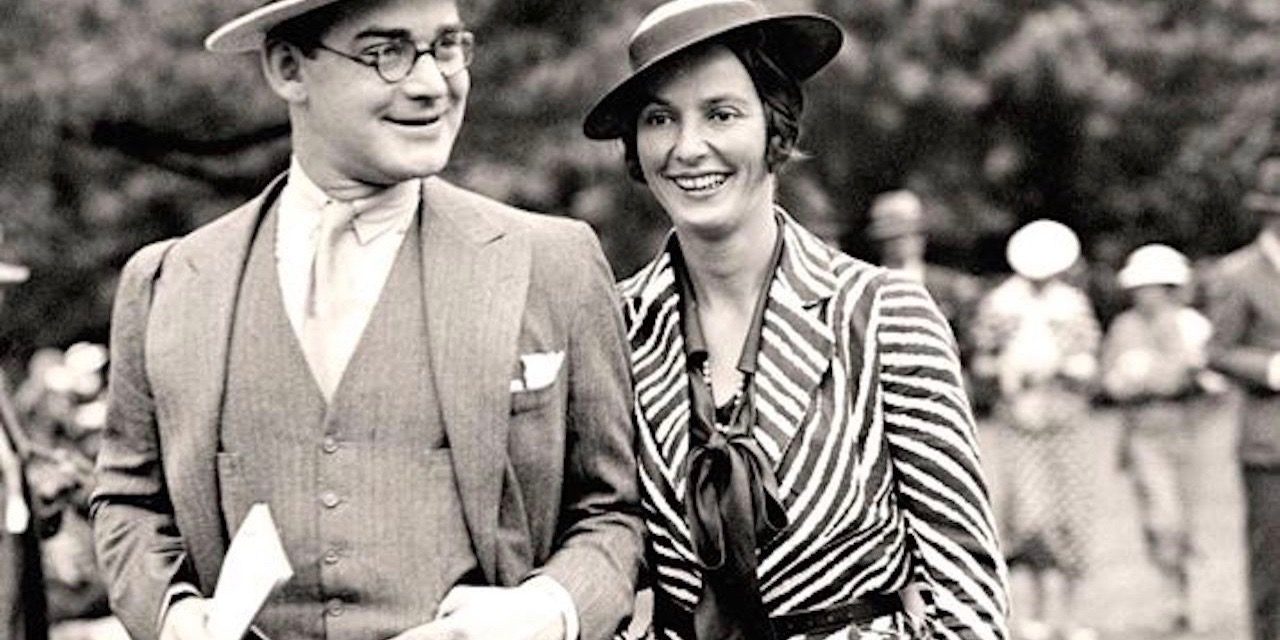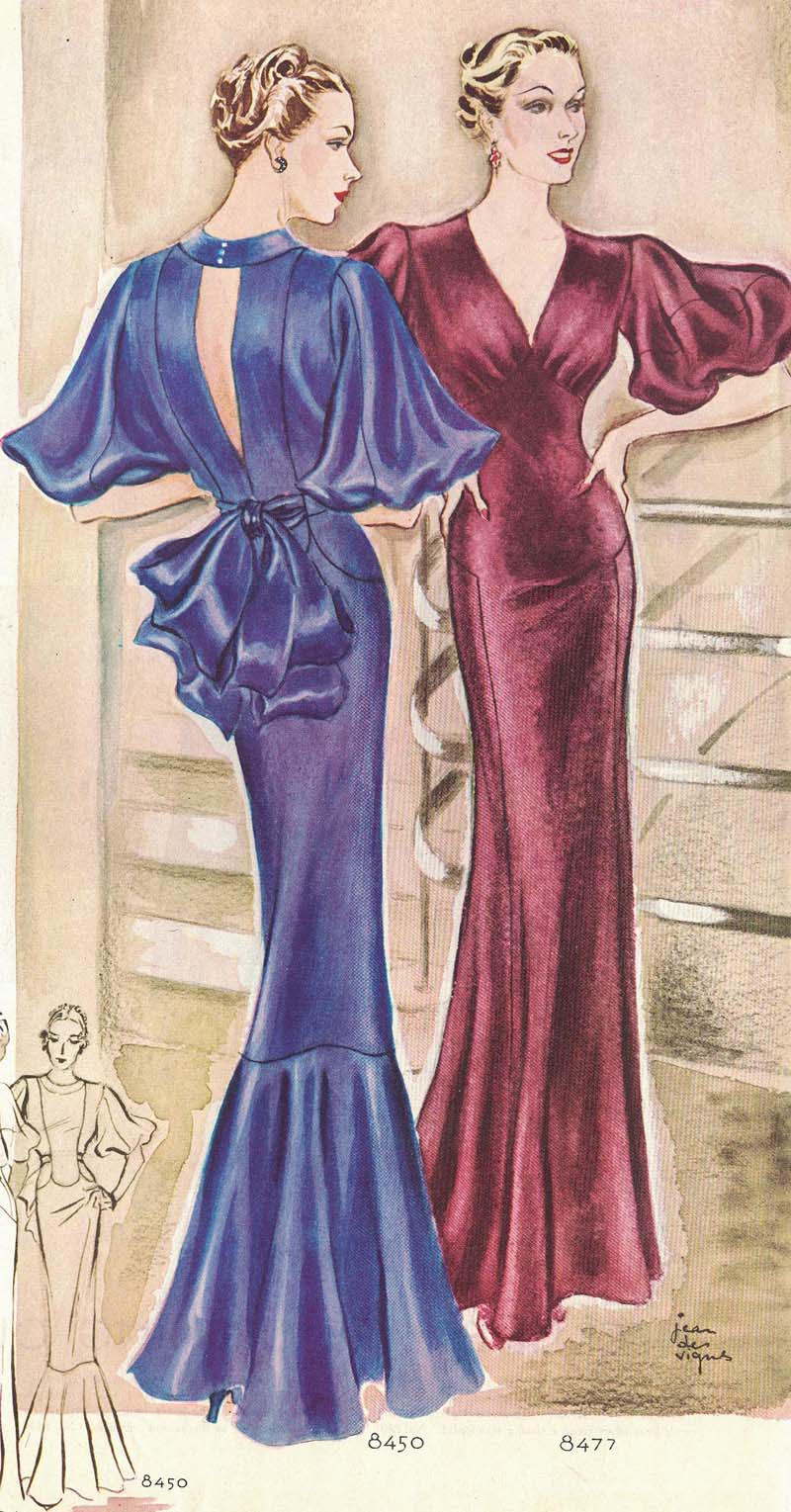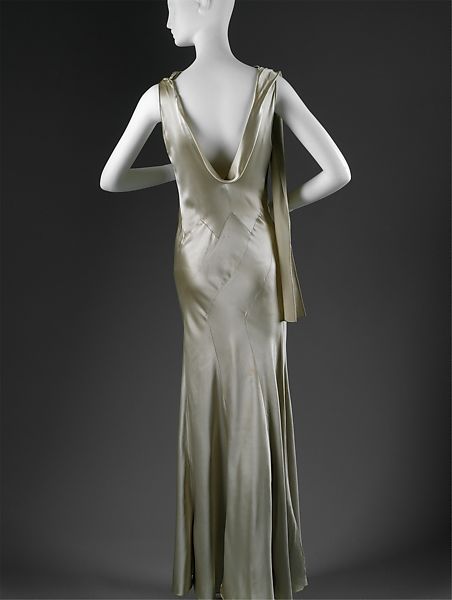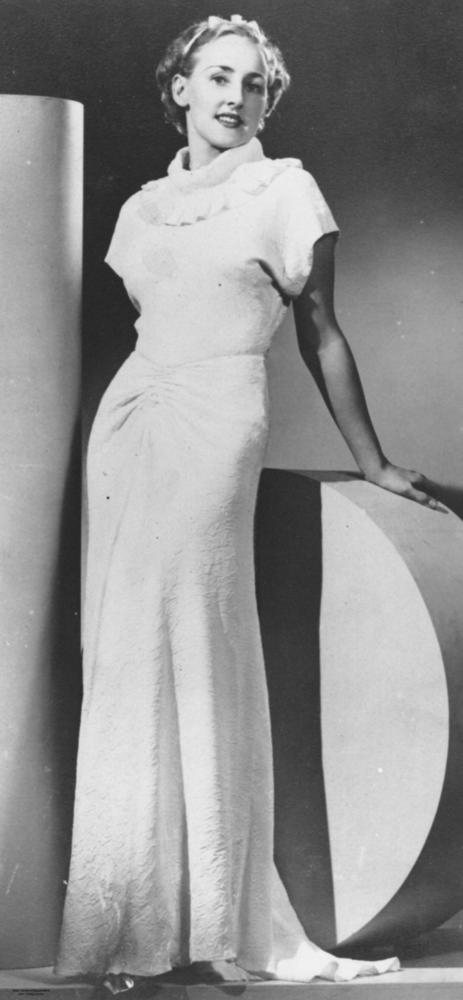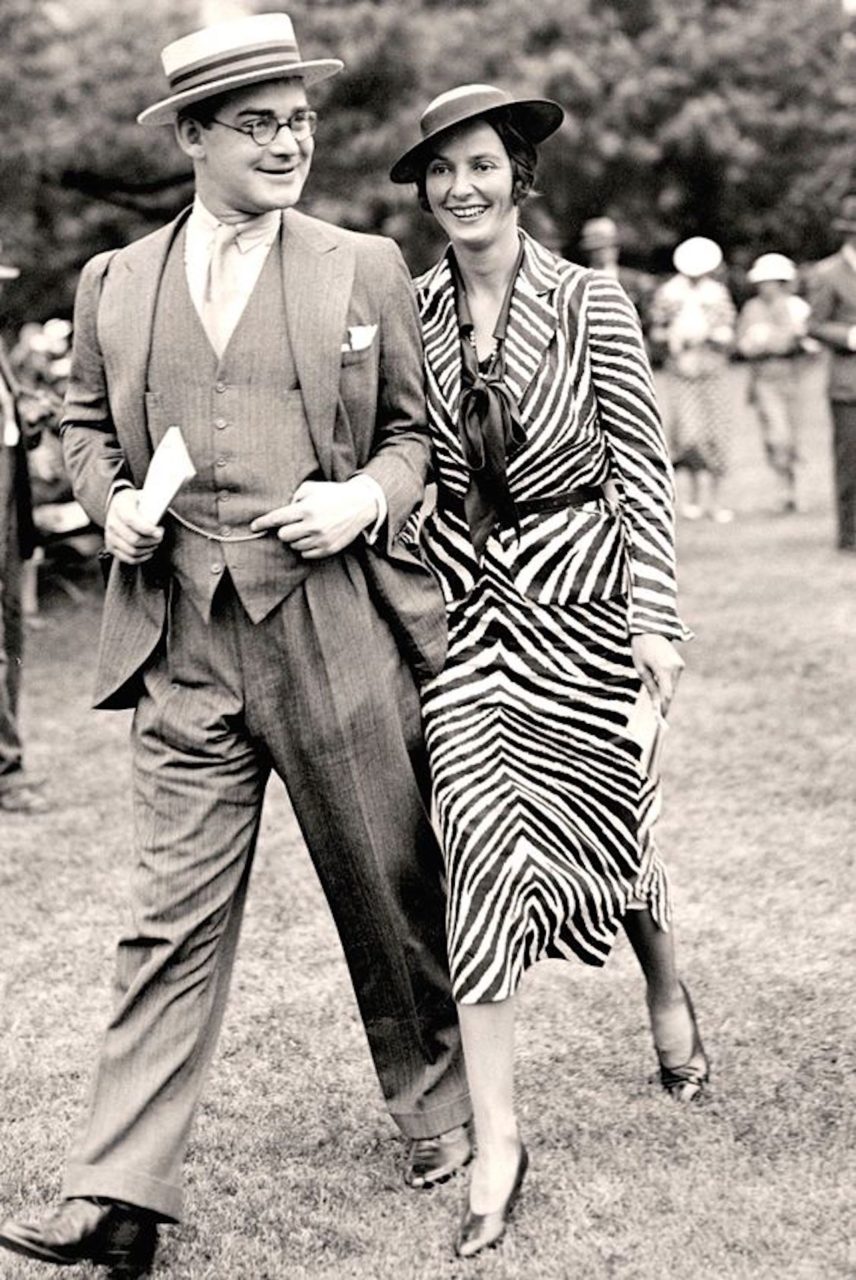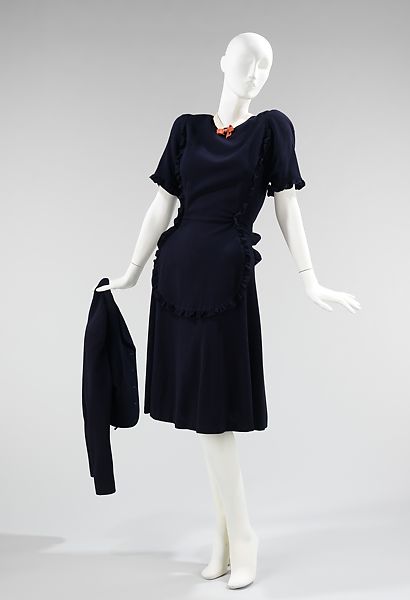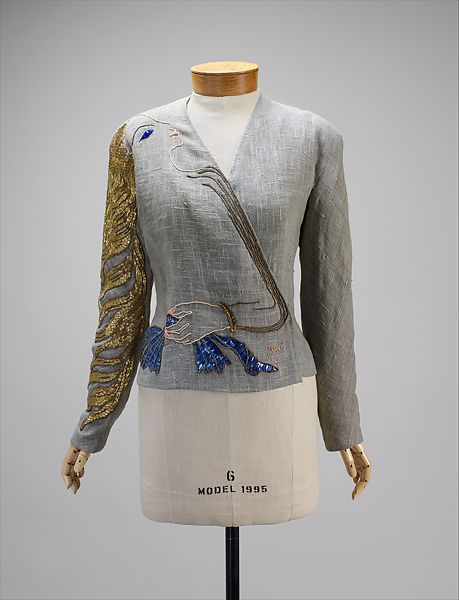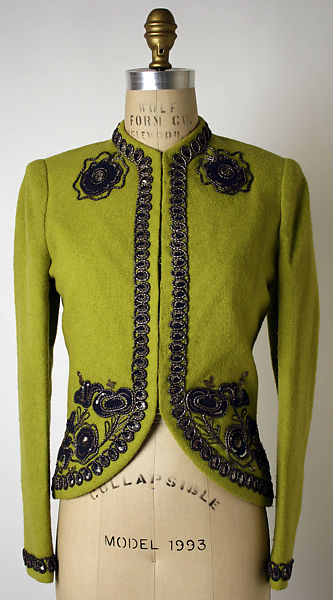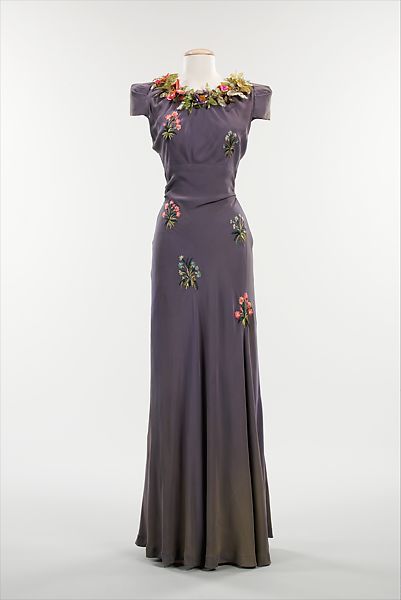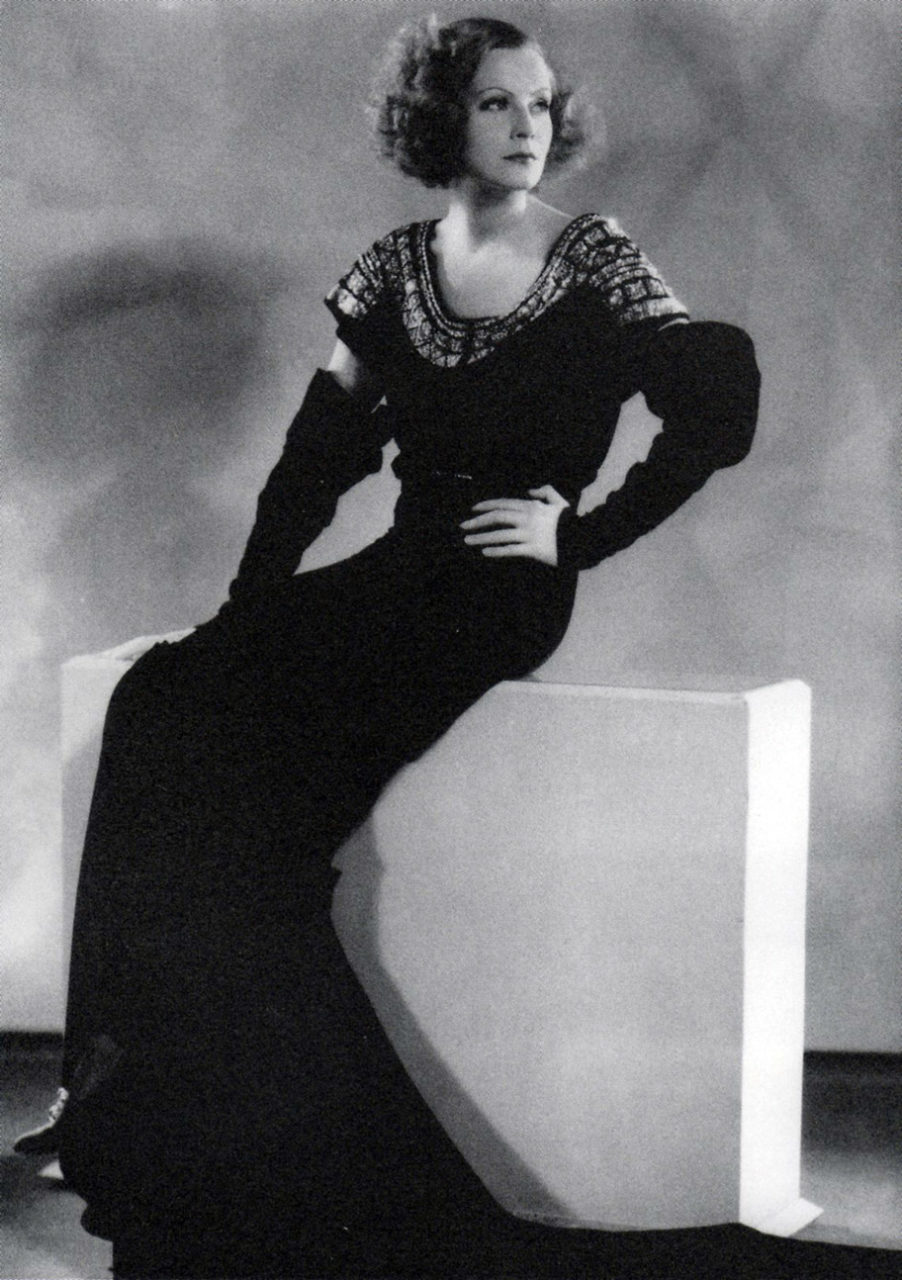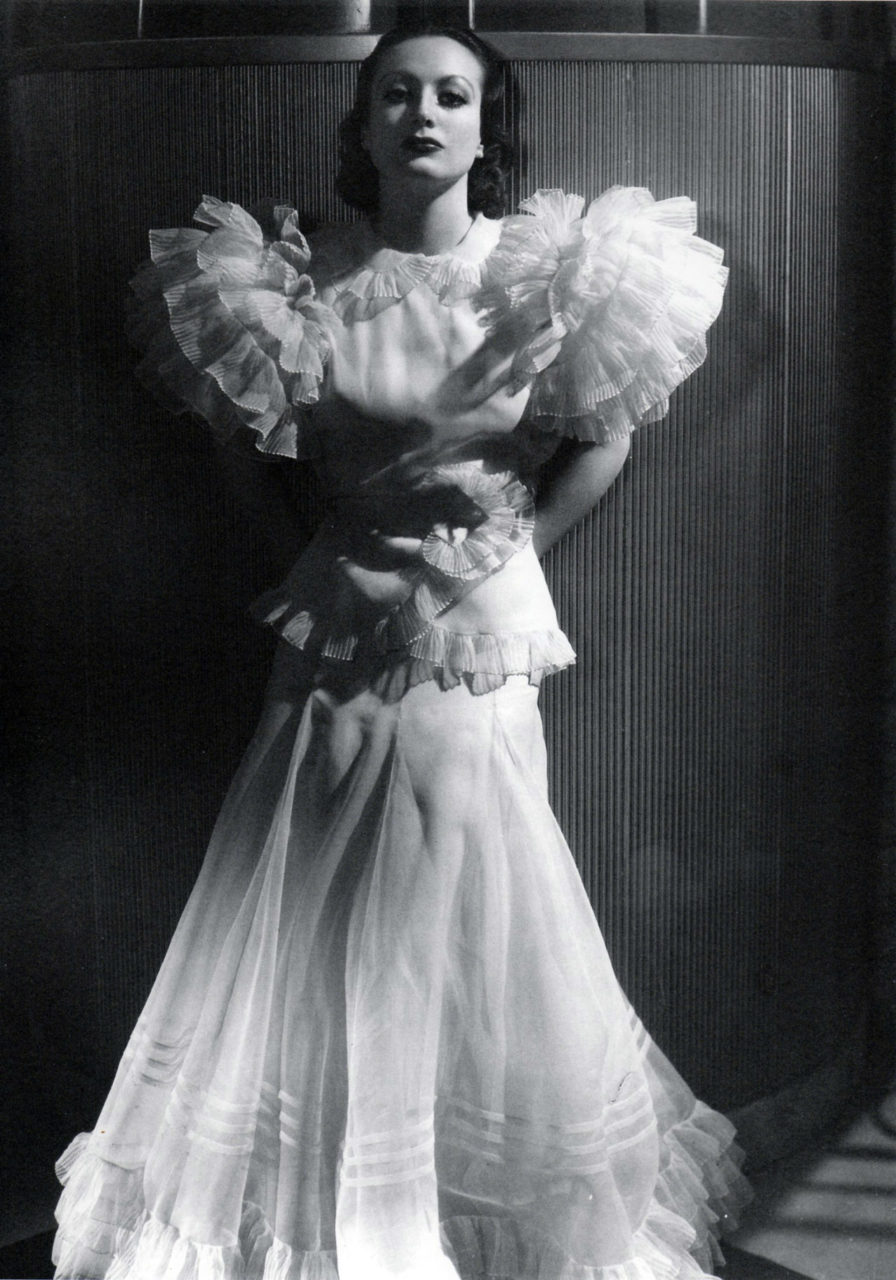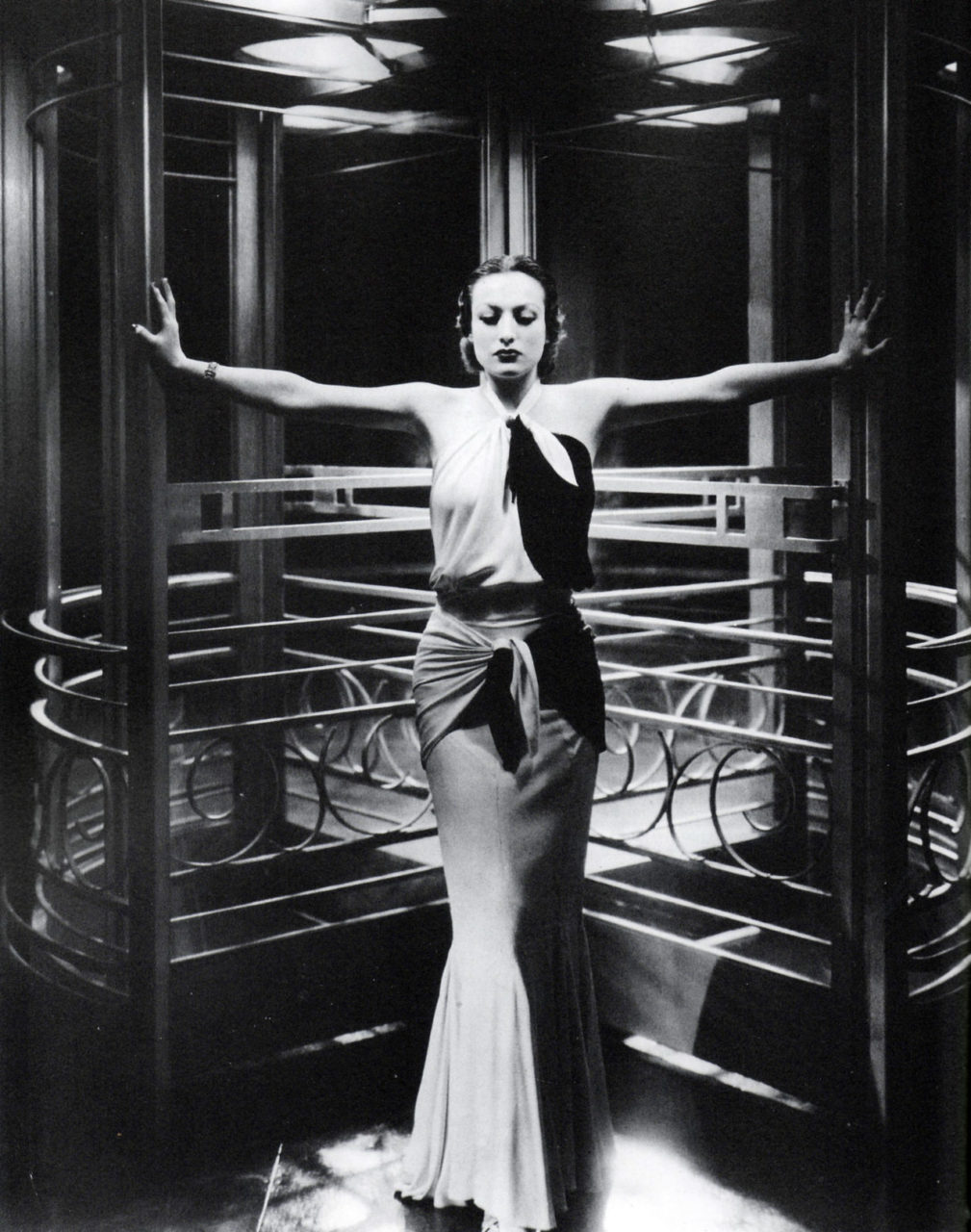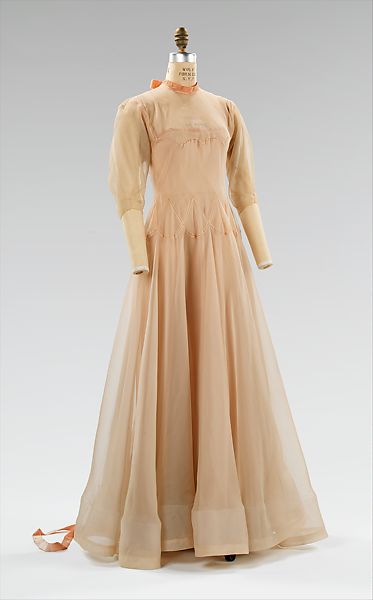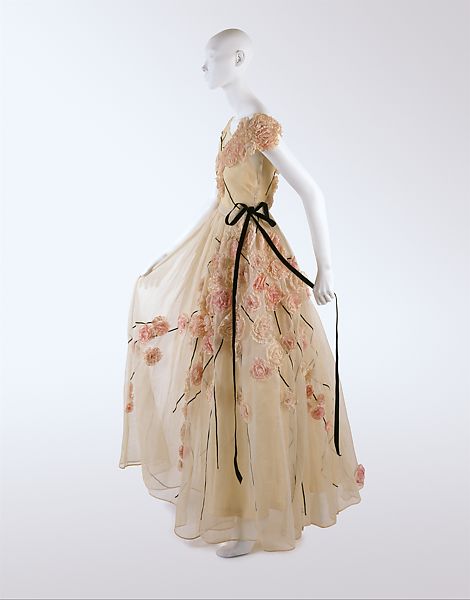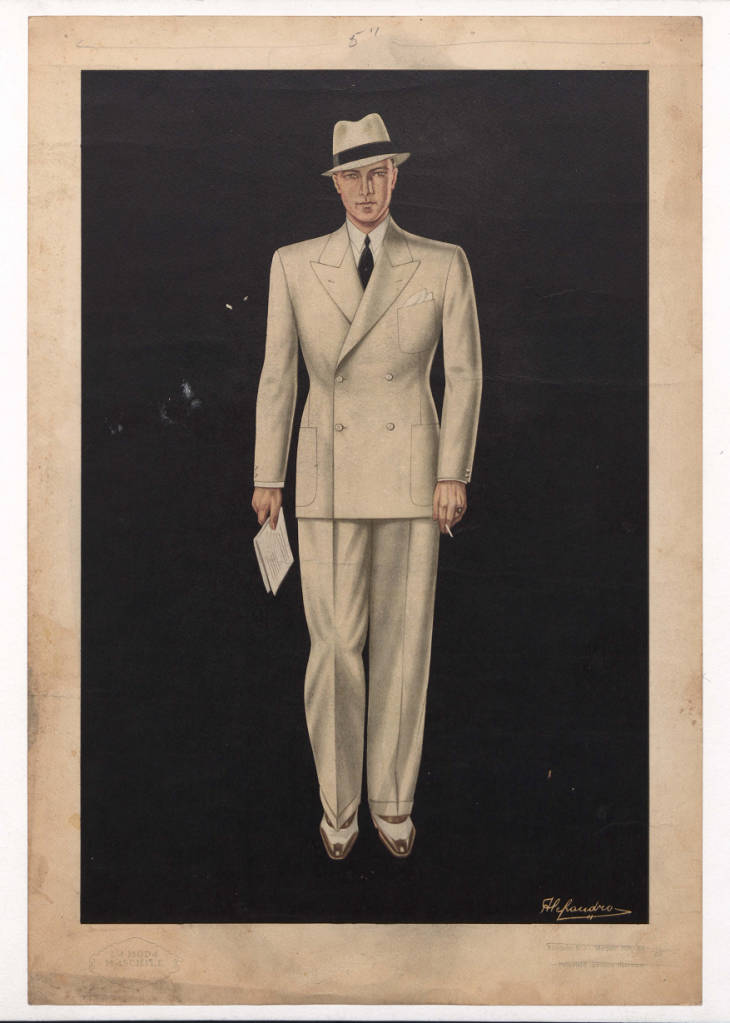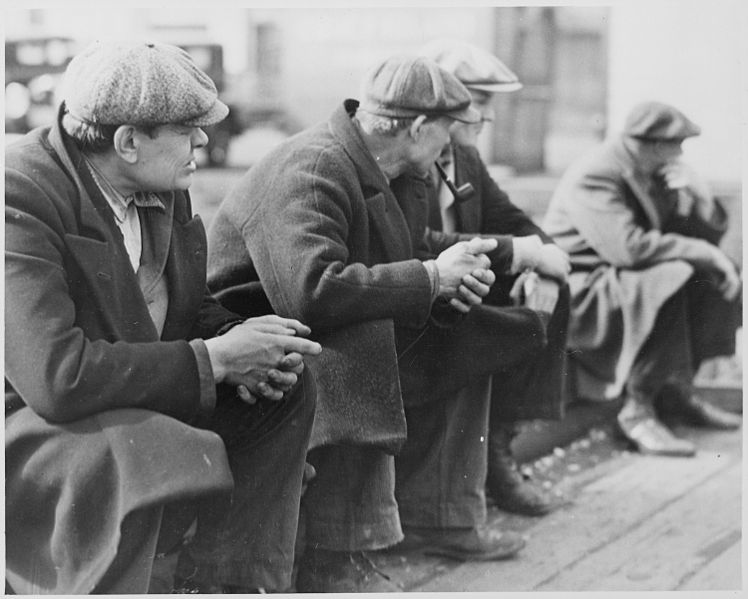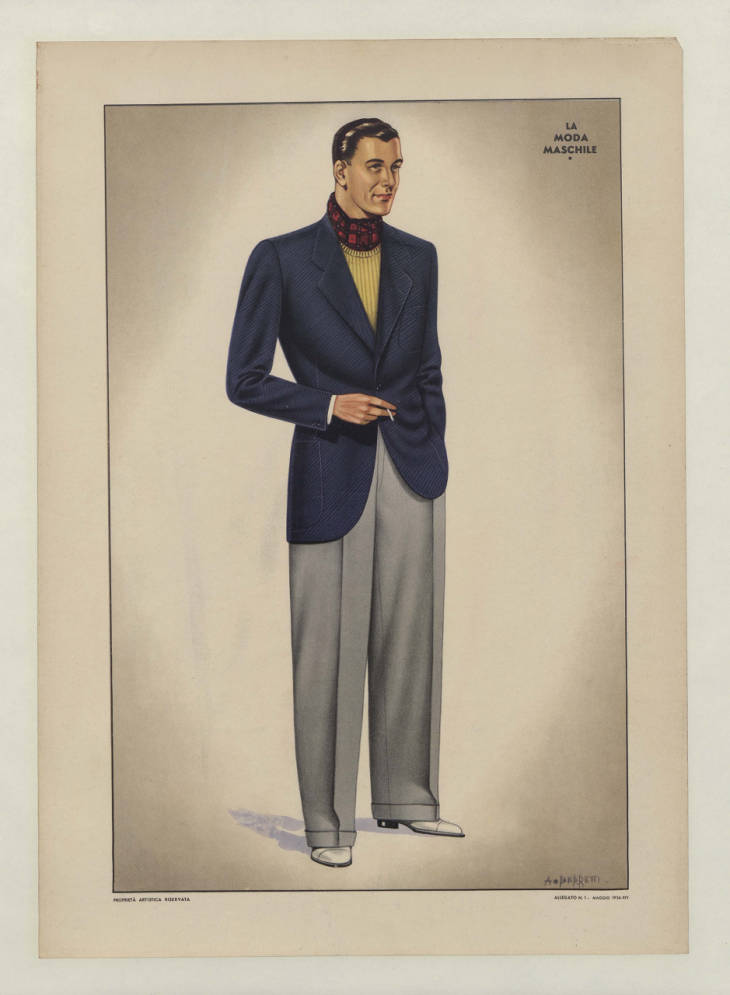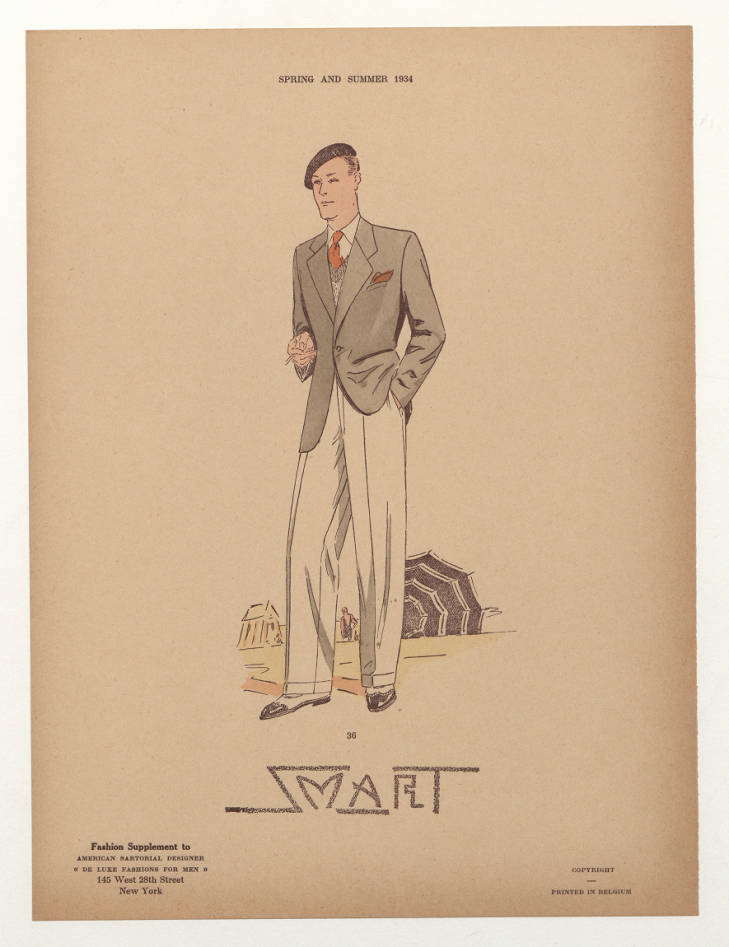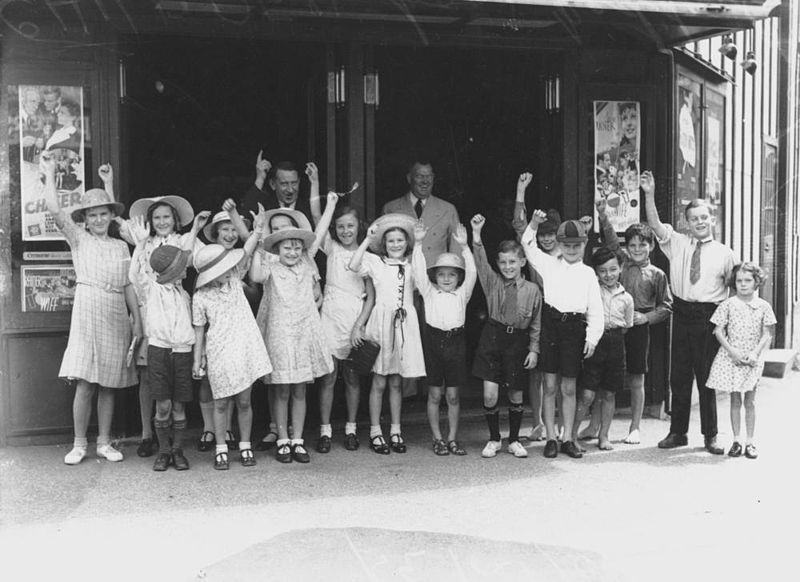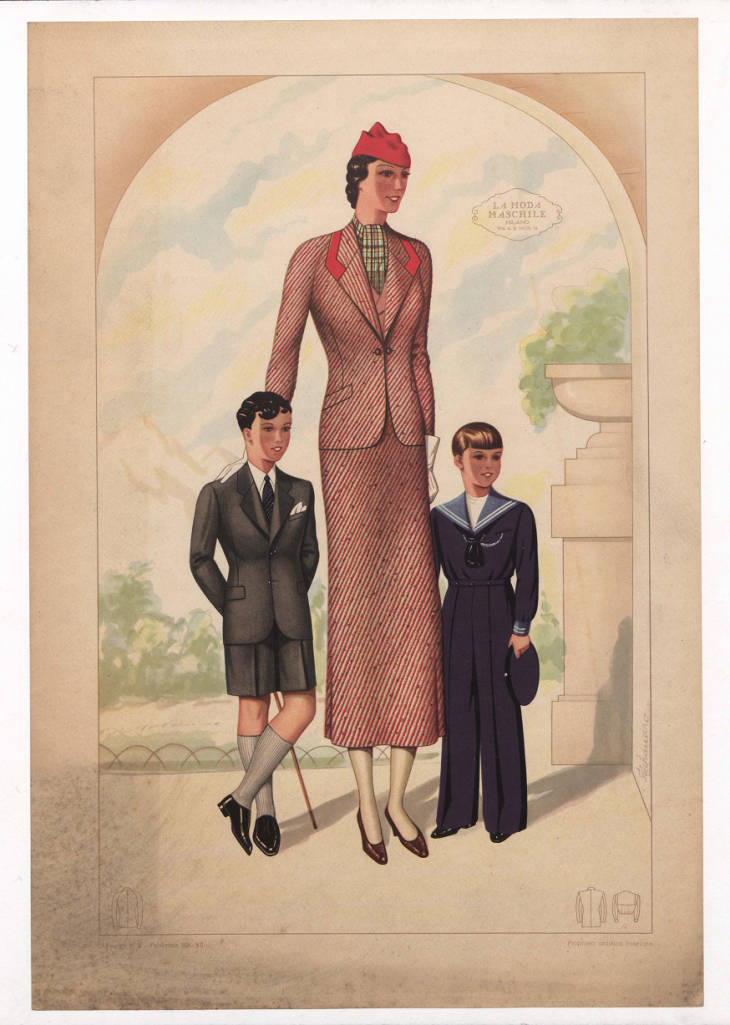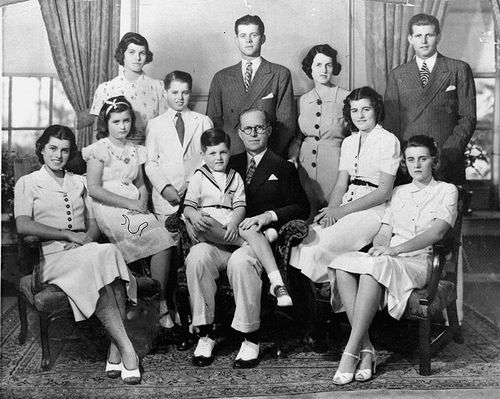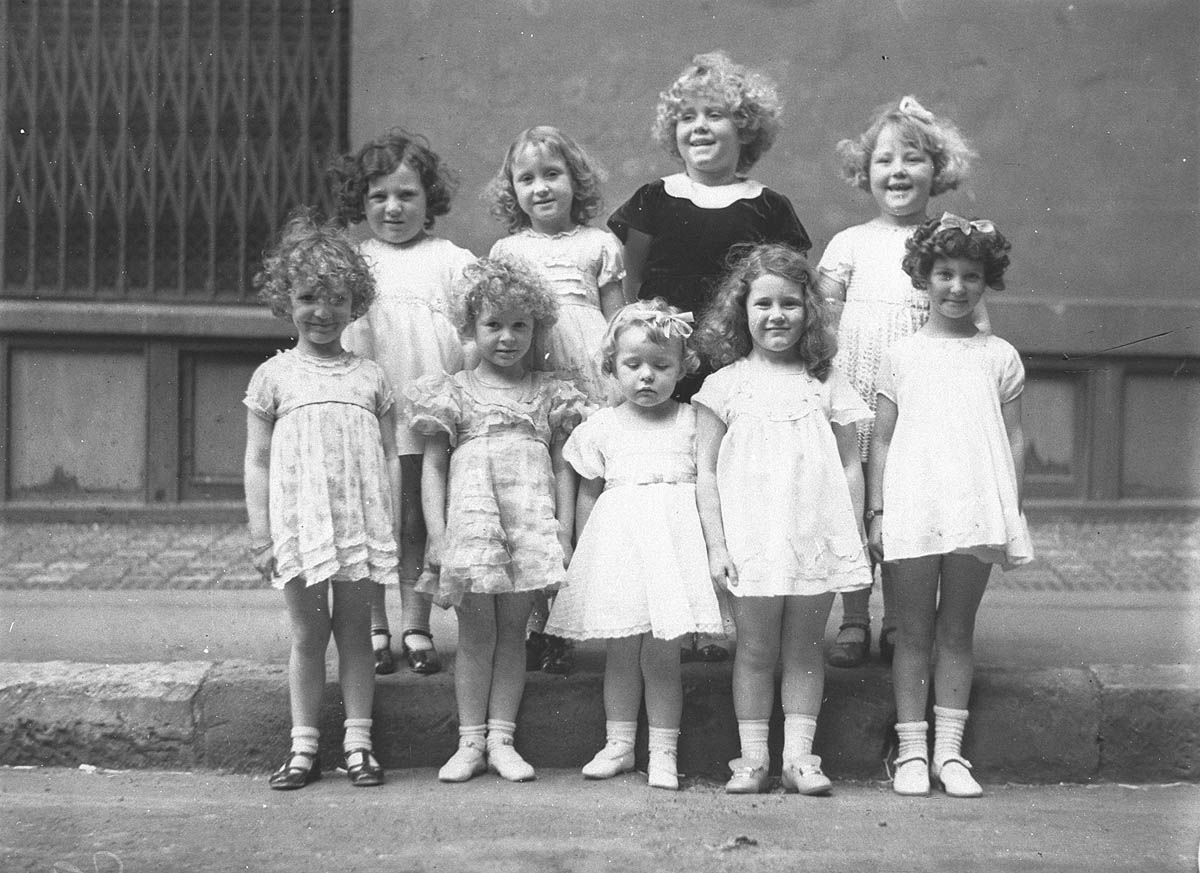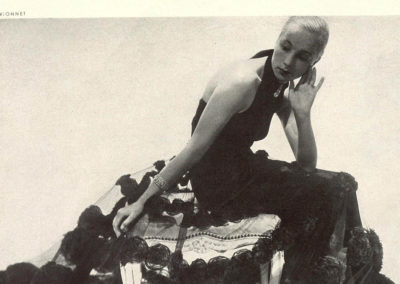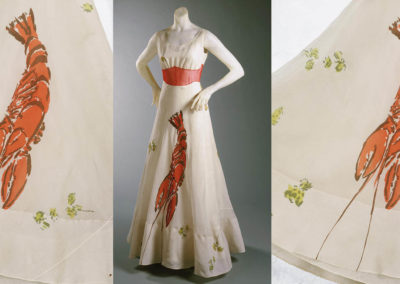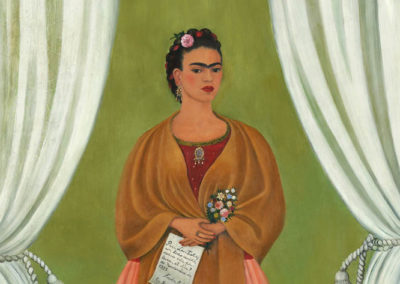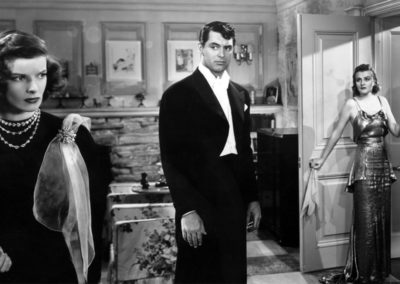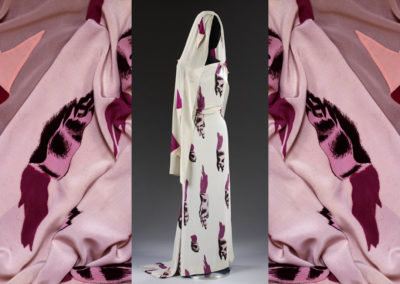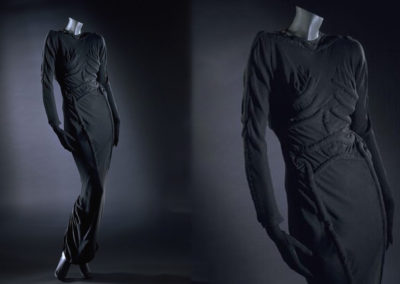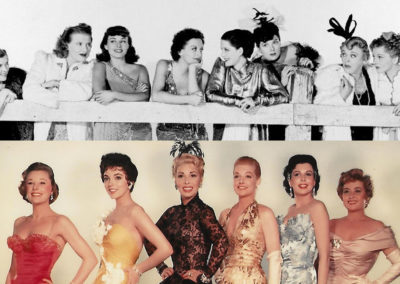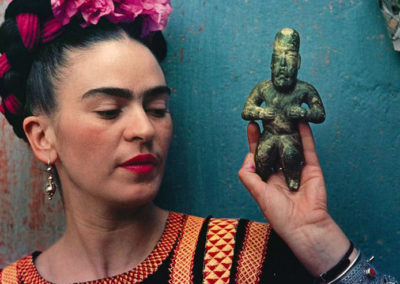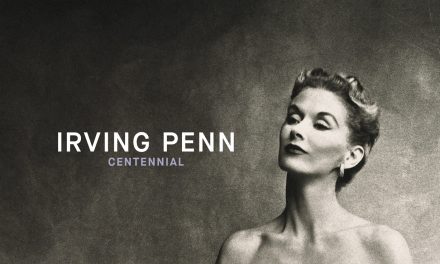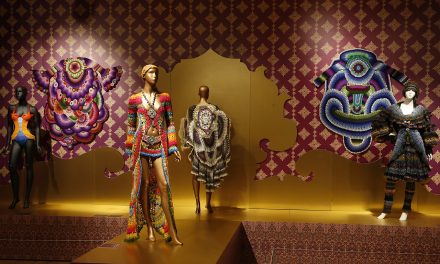OVERVIEW
In the 1930s, fashion saw a profound influence from films and specifically Hollywood. Men’s, women’s, and children’s styles were based on fashions seen on screen with stars like Clark Gable, Jean Harlow, and Shirley Temple among the many who directly influenced fashion. A return to conservatism after the Roaring Twenties also marked fashion during this period.
Womenswear
Despite these departures from the prevailing mode of the previous decade, the popular styles of the early 1930s were similar in their simple lines to the popular garçonne look of the twenties. But while the simplicity of the 1920s created a sack-like silhouette free from curves, the simple lines of the early thirties hugged those curves, creating a soft, feminine silhouette. Cally Blackman, a lecturer on the history of fashion at Central Saint Martins, writes in 100 Years of Fashion, “By the early 1930s, the fashionable silhouette was evolving into a slender, elongated torso with widening shoulders and a neat head with softly waved short hair” (13). Though the lines were simple, the overall effect was one of complete sinuous femininity with a natural waist and skirts flaring out slightly at the ankle, as seen in a fashion illustration from 1935 (Fig. 1).
Fig. 1 - McCall's Magazine. Evening Dresses, October 1935. Source: Flickr
Fig. 2 - Madeleine Vionnet (French, 1876–1975). Evening dress, ca. 1932. Silk. New York: The Metropolitan Museum of Art, 1982.422.8. Gift of Florence G. McAteer (Mrs. Howard W.), 1982. Source: The Metropolitan Museum of Art
Fig. 3 - Photographer unknown (Australian). Model posing in a glamorous evening gown, 1930s. Queensland: State Library of Queensland. Source: Flickr
Fig. 4 - Gabrielle Chanel (French, 1883–1971). Evening dress, 1930s. Silk. New York: The Metropolitan Museum of Art, C.I.62.44.9a, b. Gift of Mr. and Mrs. Maxime L. Hermanos, 1962. Source: The Metropolitan Museum of Art
Contributing to the overall slender look of the early thirties was one of the most important developments and trends of the decade: the bias cut. To cut fabric on the bias means cutting the fabric 45 degrees against the weave, creating a fluid, body-skimming garment (Morton). Designer Madeleine Vionnet began using the bias cut in the 1920s, and in the thirties, it became a popular method of creating dresses that skimmed over women’s curves. Especially in the evening, satin dresses with low backs, like the silvery Vionnet dress from 1932 (Fig. 2), created a slinky and feminine silhouette, flaring out at the bottom and hugging curves that had not previously been hugged, like the white gown worn by the model in figure 3. Other designers also used the method, as seen in the light pink Chanel dress from the 1930s (Fig. 4).
While eveningwear became dominated by the body-skimming silhouette, daywear returned to romanticism and femininity. Day dresses came in a variety of patterns: floral, plaid, dots, and more abstract prints, like the zebra print suit in figure 5. They had clearly defined waists and fell between the mid-calf and just above the ankle. Smart suits were popular with crisp lines and sculptural, defined shoulders, like those in the Edward Molyneux dress from 1939 (Fig. 6). The exaggerated shoulder–on suits or dresses–was a hallmark of 1930s fashion and was created through padding, layers of fabric, or other embellishments.
Having gained popularity in the 1920s, designer Elsa Schiaparelli took her designs to another level in the 1930s, collaborating with surrealist artists such as Salvador Dalí and Jean Cocteau. She used drawings by the latter to adorn her garments, like the linen jacket from 1937 that shows a woman’s head with her hair a cascade of sequins down one arm (Fig. 9). While many of her collections were grounded in the prevailing mode, they included unique embellishment and twists that were uniquely hers. The purple dress from her 1938 Pagan collection follows a popular construction, but the highly embellished neckline and structural shoulders are quintessential Schiaparelli (Fig. 7). Impeccably tailored, her designs in the thirties championed the strong shoulder and cinched in waist that defined the period, as seen in the vibrant green jacket (Fig. 8).
Fig. 5 - Photographer unknown. Mid 1930s Zebra Print, 1930s. Source: Pinterest
Fig. 6 - Edward Molyneux (French, 1891–1974). Ensemble, 1939. Wool and silk. New York: Brooklyn Museum Costume Collection at The Metropolitan Museum of Art, 2009.300.164a, b. Gift of the Brooklyn Museum, 2009; Gift of Bettina Ballard, 1952. Source: The Metropolitan Museum of Art
Fig. 7 - Elsa Schiaparelli and Jean Cocteau (Italian/French, 1890–1973/1889–1963). Evening jacket, Fall 1937. Linen, metal. New York: The Metropolitan Museum of Art, 2009.421. Purchase, Friends of The Costume Institute Gifts, 2009. Source: The Metropolitan Museum of Art
Fig. 8 - Elsa Schiaparelli (Italian, 1890–1973). Jacket, 1938. Wool, silk, metallic thread, sequins. New York: The Metropolitan Museum of Art, 1978.288.18. Gift of Julia B. Henry, 1978. Source: The Metropolitan Museum of Art
Fig. 9 - Elsa Schiaparelli (Italian, 1890–1973). Evening dress, Fall 1938. Silk, plastic, metal. New York: Brooklyn Museum Costume Collection at The Metropolitan Museum of Art, 2009.300.1166a, b. Gift of the Brooklyn Museum, 2009; Gift of Millicent Huttleston Rogers, 1951. Source: The Metropolitan Museum of Art
Fig. 10 - Artist unknown. Greta Garbo, "Inspiration", 1930. Laura Loveday. Source: Flickr
Fig. 11 - Bettmann/CORBIS. Marlene Dietrich, 1930. Kristine. Source: Flickr
Increasingly, women looked to movie stars for fashion inspiration during this period. Hollywood disseminated fashion to the masses and stars like Greta Garbo (Fig. 10), Marlene Dietrich (Fig. 11), and Bette Davis, among others, became some of the first Hollywood style icons. Many women all over the world attempted to emulate their style. Making this a little easier was a rise in makeup and the beauty industry, allowing women to copy their favorite stars at a small cost. Blackman writes:
“Every woman could imitate and buy into, at relatively little cost, the look of her favourite stars, if only through copying their makeup and hairstyles: cinema democratized the empire of fashion by making glamour accessible.” (14)
Of course, the Depression also had an influence on fashion, contributing to this democratization, especially in the United States. Before the 1930s, buyers would purchase copies of Paris designs and resell them in their home countries. However, as the Great Depression affected all areas of business and life in the US, new duties of ninety percent were imposed on the cost of these copies (Laver 246). However, toiles (a muslin or other cheap material pattern of a garment) were allowed in duty-free. Fashion historian James Laver writes, “Each toile was supplied with full directions for making it up, and although the original dress may have cost a hundred thousand francs, it was now possible to sell a simplified version for as little as fifty dollars” (246).
By the end of the decade, Europe had entered into the Second World War and the US still had not yet left the Great Depression behind. As the thirties closed, the popular style of broad, padded shoulders, nipped in waists and shorter A-line skirts that would dominate the early 1940s had already emerged.
Fashion Icon: Joan Crawford
Designed by MGM costume designer Gilbert Adrian, with whom Crawford (and other stars) would continue to work with on- and off-screen for years, the dress diverged from the body-skimming dresses the public had become used to in the early thirties. Instead, the white dress had a nipped in waist, full skirt, and huge puffed sleeves created with layers of translucent white organdie. So popular was the dress that it was copied at all price points in a phenomenon we readily recognize today but was new with the advent of the movie industry. Macy’s alone sold in the region of half a million copies of the Adrian design in 1932 (Maryland Historical Society). Its design also helped inspire a return to romanticism in 1930s fashion and the dress influenced designs that did not directly copy it but took inspiration from the feminine style as seen in the mid-1930s Vionnet gown (Fig. 14) and a 1937 Lanvin gown (Fig. 15).
Crawford continued to work with Adrian throughout the decade both on film and in her personal life. Adrian designed knockout looks for Crawford that flattered her body shape and despite the popularity of the Letty Lynton dress, she also wore the slinky styles that were popular in the decade (Fig. 13). She is still remembered for her iconic style today.
Fig. 12 - Photographer unknown. Joan Crawford, "Letty Lynton", 1932. Laura Loveday. Source: Flickr
Fig. 13 - Photographer unknown. Joan Crawford, 1932. Laura Loveday. Source: Flickr
Fig. 14 - Madeleine Vionnet (French, 1876–1975). Evening dress, ca. 1937. Silk. New York: Brooklyn Museum Costume Collection at The Metropolitan Museum of Art, 2009.300.2522a, b. Gift of the Brooklyn Museum, 2009; Gift of Mrs. Anthony Wilson, 1963. Source: The Metropolitan Museum of Art
Fig. 15 - Jeanne Lanvin (French, 1867–1946). Dress, 1937. Cotton and silk. New York: The Metropolitan Museum of Art, C.I.58.34.19a, b. Gift of Mrs. John Chambers Hughes, 1958. Source: The Metropolitan Museum of Art
Menswear
Fig. 16 - Clark Gable and Claudette Colbert. It Happened One Night, 1934. Source: Wikimedia
Fig. 17 - Artist unknown (Italian). Menswear 1930s- Italian, Plate 021, 1930s. New York: The Met, Costume Institute Fashion Plates. Gift of Woodman Thompson. Source: The Met Digital Collections
Fig. 18 - Lewis Hine (1874-1940). Row of men at the New York City docks out of work during the depression, 1934. National Archives at College Park. Source: Wikimedia
Like womenswear, menswear saw a shift of focus to the movies for fashion inspiration in the 1930s. Just as women’s fashion had begun to democratize in the twenties, men’s fashion followed suit. Fashion writer Colin McDowell writes in The Man of Fashion: Peacock Males and Perfect Gentlemen of the power movies had over men’s fashion in the thirties, recalling that sales of undershirts slumped when Clark Gable (Fig. 16), revealed that he wasn’t wearing one in 1934’s It Happened One Night (111). Here, we see the shift of influence from the elite, such as the Duke of Windsor, to working-class heroes of the movies. McDowell continues:
“The images of the cinema broke a pattern of fashion which had prevailed for centuries, giving birth to the blue-collar style leader. With rare exceptions, all previous fashion had been created by a social elite whose greatest claims were exclusivity and wealth. Now, fashion was to percolate up through the classes, instead of down.” (111)
While suits were still worn for formal occasions and work, casual wear such as knitted sweaters and soft-collared shirts became increasingly popular during the day, like the styles seen in figures 19 and 21. Even ties were no longer obligatory.
As menswear became more democratic, men’s fashion became more defined by what was absent than what was present. Men’s fashion continued to become less formal and McDowell remarks on the traditional pieces of a man’s wardrobe that were abandoned in the thirties:
“The list of rejects from his wardrobe in the 1920s and 1930s is impressive: formal dress boots, spats, gloves, canes, waistcoats and vests, stiff collars (except with a city suit), even white tie and tails; all were facing virtual extinction.” (113)
Of course, formalwear did not disappear altogether, and the tuxedo continued to be a popular choice. New material such as sharkskin, a synesthetic fabric, gained in popularity for suits in the mid-to-late thirties while white tuxedos were a favorite in warm climates (Fashion and Textile Museum, Fig. 17).
Fig. 19 - Artist unknown (Italian). Menswear 1930s- Italian, Plate 046, 1930s. New York: The Met, Costume Institute Fashion Plates. Gift of Woodman Thompson. Source: The Met Digital Collections
Fig. 20 - F. Scholte, Forster & Son, Ltd. (British). Suit, 1933. Wool, brass. New York: The Metropolitan Museum of Art, 1974.185.8a–c. Gift of the Duchess of Windsor, 1974. Source: The Metropolitan Museum of Art
Fig. 21 - Artist unknown (American). Menswear 1930s-American, Plate 004, 1930s. New York: The Met, Costume Institute Fashion Plates. Gift of Woodman Thompson. Source: The Met Digital Collections
Sports, physical activity, and the sun continued to have an influence on men’s fashion in the thirties as they had in the twenties. Tennis, golf, and a healthy suntan, which all saw a rise in popularity in the 1920s, continued to hold sway in the thirties (Fashion and Textile Museum). Going hand-in-hand with film’s influence on the democratization of men’s fashion, blazers and sports jackets with flannel trousers and open-necked shirts were popular styles for men in the 1930s that took from sporting pursuits, as seen in figure 22.
While no longer as wide as the previous decade’s Oxford bags, trouser legs continued to be wide at the bottom and worn creased and cuffed. Plus-fours, like the Duke of Windsor’s 1933 suit in figure 20, continued to be worn by many and tweed continued to be a popular material. When suits were worn, jackets had wide, padded shoulders and tapering sleeves. Perhaps foreshadowing what was to come, military-inspired trends such as the trench coat and the leather “Bomber” jacket also saw popularity in the 1930s as casual outerwear. An enduring image of the Great Depression are men, like those in Fig. 18, in worn boots, large overcoats, and a flat cap. For some, this was all the fashion they could afford during the thirties.
Fig. 22 - Artist unknown. Menswear 1930s-English, Plate 001, 1933. New York: The Met, Costume Institute Fashion Plates. Gift of Woodman Thompson. Source: The Met Digital Collections
CHILDREN’S WEAR
Sailor suits and dresses continued to be a popular style for both young boys and girls, especially for young boys, as seen in the fashion plates in figures 24 and 25. Age continued to dictate whether a young boy wore shorts or long trousers with younger boys wearing corduroy shorts and cotton shirts. Boys’ clothing largely echoed their adult counterparts as they got older, with wool and flannel suits being worn by older boys. Trousers were worn with a belt or suspenders while sweaters or sweater vests were worn over collared cotton shirts. The image of Joe and Rose Kennedy with their nine children in the late 1930s illustrates what young people were wearing at various stages of childhood, adolescence, and young adulthood during the thirties (Fig. 26).
Due to the Great Depression, a phenomenon among children’s clothing in the US, especially for girls, was the flour sack dress (Casely). As times became more and more desperate during the decade, women turned to the cotton sacks flour came in at the time. They began making clothing out of the emptied bags and once flour manufacturers found out, they began printing patterns onto the sacks. Women made dresses for themselves and their children–both girls and boys– but young girls often sported these “make-do” dresses. While they may not have been the height of fashion, they show how even those hit hardest by the Depression were able to update their wardrobe.
Fig. 23 - Photographer unknown. Children at Cremorne Theatre, Brisbane, 1938. Queensland: John Oxley Library, State Library of Queensland. Source: Wikimedia
Fig. 24 - Aritst unknown (Italian). Menswear 1930s- Italian, Plate 010, 1934. New York: The Met, Costume Institute Fashion Plates. Gift of Woodman Thompson. Source: The Met Digital Collections
Fig. 25 - Artist unknown (Italian). Menswear 1930s- Italian, Plate 011, 1934. New York: The Met, Costume Institute Fashion Plates. Gift of Woodman Thompson. Source: The Met Digital Collections
Fig. 26 - Photographer unknown. Kennedy family portrait, ca. late 1930s. Source: Pinterest
FASHION ICON: SHIRLEY TEMPLE
Fig. 27 - Photographer unknown. Shirley Temple, 1930s. Source: Pinterest
Fig. 28 - Sam Hood. Nine girls in a Fox Films and Daily Telegraph Shirley Temple look-alike contest, 1934. Glass photonegative. State Library of New South Wales. Source: Flickr
It was those ringlets and her frilly, girly dresses that influenced young girls’ fashion during the decade (Fig. 27). Having made her film debut in 1934, just a year later in 1935, Sears Roebuck featured a Shirley Temple line of fashions for girls inspired by the child actor’s roles (Vaughan Lee). This included coats, shift dresses, party dresses, and even snow suits.
Shirley Temple’s little girl style made an indelible mark on 1930s culture. Her party dresses with layers of petticoats influenced formalwear while collared and smocked shift dresses were easily emulated on a day-to-day basis. Contests, like the one held in Sydney, Australia in October 1934, saw young girls turned out in their best dresses and Shirley Temple ringlets (Fig. 28). Even today, when 1930s children’s fashion is mentioned, your mind probably jumps to Shirley Temple, such was her influence on the enduring image of little girls during the Depression.
References:
- Blackman, Cally. 100 Years of Fashion. Great Britain: Laurence King Publishing, 2012. http://www.worldcat.org/oclc/933598458.
- Casely, Laura. “1930s Flour Sacks Featured Colorful Patterns for Women to Make Dresses.” Little Things. Accessed March 29, 2019. https://www.littlethings.com/flour-sack-dresses/4.
- DuzinkiewiczBaker, Therese. “Gilbert Adrian – Fashion Designer Encyclopedia.” Fashion Encyclopedia. Accessed March 29, 2019. http://www.fashionencyclopedia.com/A-Az/Adrian-Gilbert.html.
- Esquevin, Christian. “Joan Crawford Fashion – Designed by Adrian,” July 28, 2016. Silver Screen Modes. Accessed March 29, 2019. http://silverscreenmodes.com/joan-crawford-screen-fashion-designed-by-adrian/.
- Fashion and Textile Museum. Night and Day: 1930s Fashion and Photographs. London, 2018. https://www.ftmlondon.org/ftm-exhibitions/night-and-day-1930s-fashion-and-photographs/
- Harmetz, Aljean. “Shirley Temple Black, Hollywood’s Biggest Little Star, Dies at 85,” February 11, 2014. The New York Times. Accessed March 29, 2019. https://www.nytimes.com/2014/02/12/arts/shirley-temple-black-screen-star-dies-at-85.html.
- Laver, James, Amy De La Haye, and Andrew Tucker. Costume and Fashion: A Concise History. 5th ed. New York: Thames & Hudson, 2012. http://www.worldcat.org/oclc/966352776.
- Maryland Historical Society. “The Letty Lynton Effect.” Accessed March 29, 2019. http://blog.mdhs.org/costumes/the-letty-lynton-effect.
- McDowell, Colin. The Man of Fashion: Peacock Males and Perfect Gentlemen. London: Thames & Hudson, 1997. http://www.worldcat.org/oclc/924853619.
- Morton, Camilla. “Fashion A-Z: Bias Cut.” Business of Fashion. Accessed March 29, 2019. https://www.businessoffashion.com/education/fashion-az/bias-cut.
- O’Hanlon, Teresa. “Types of Clothing That Kids Would Have Worn in the 1930s.” Classroom. Accessed March 29, 2019. https://classroom.synonym.com/types-kids-would-worn-1930s-6859193.html.
- University of Vermont Landscape Change Program. “Men’s Fashions.” Accessed March 29, 2019. https://www.uvm.edu/landscape/dating/clothing_and_hair/1930s_clothing_men.php.
- Vaughan Lee, Heather. “Shirley Temple (Black) 1928-2014,” February 11, 2014. Fashion Historia. Accessed March 29, 2019. http://fashionhistorian.net/blog/2014/02/11/shirley-temple-black-1928-2014/.
- Victoria and Albert Museum. “History of Fashion 1900 – 1970.” Accessed March 29, 2019. http://www.vam.ac.uk/content/articles/h/history-of-fashion-1900-1970/.
- Victoria and Albert Museum. “Introduction to 20th Century Fashion.” Accessed March 29, 2019. http://www.vam.ac.uk/content/articles/i/introduction-to-20th-century-fashion/.
Historical Context
Wikipedia: 1930-1939
Events:
- 1930 – As fashion becomes more conservative, dresses are generally styled with a lower hemline.
- 1932 – Flying Down to Rio pairs Fred Astaire and Ginger Rogers for the first time. Astaire was an impeccable dresser on and off the screen, favoring suits made on London’s Savile Row. The movie Letty Lynton by MGM, starring Joan Crawford, begins a craze for padded shoulders in the US.
- 1934 – The word “brassiere” is gradually shortened to “bra” through the decade. According to a survey by Harper’s Bazaar, “bra” is the most commonly used expression among college women for the brassiere. Women’s sports clothes become briefer than ever. Bathing suits are slashed and backless, and shorts begin to be seen on the tennis court.
- 1935 – Italian-born Elsa Schiaparelli opens her first designer Boutique at 21 Place Vendôme, Paris, France. Nylon is invented by Wallace Carothers at DuPont’s research facility. It is used as a substitute for silk in many different products.
- 1936 – Edward VII abdicated the throne of England. His American mistress, Mrs. Wallis Simpson, is dressed by Mainbocher for their wedding. As more women take on paid employment, daytime looks are tailored and angular, with square epauletted shoulders, frogging, plumed hats, low heels, and gauntlet gloves.
- 1937 – The Spanish designer Cristobal Balenciaga opens his couture house in Paris. He had boutiques in Spain since 1918.
- 1939 – England and France declare war on Germany in September 1939. Clothes have to be practical. Vogue patterns are now pants for volunteer drivers. Sweaters become the basis of most looks; skirts are long and full. Gone With The Wind is released, picking up brilliantly on the air of insecurity and emphasizing a feminine, romantic note in a fashion that would not be seen again until Dior’s New Look in 1947.
Timeline Entries
Primary/Period Sources
Resources for Fashion History Research
To discover primary/period sources, explore the categories below.
Have a primary source to suggest? Or a newly digitized periodical/book to announce? Contact us!
Periodicals (Digitized)
Filmography
Secondary Sources
Also see the 20th-century overview page for more research sources... or browse our Zotero library.

